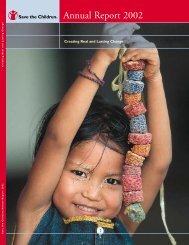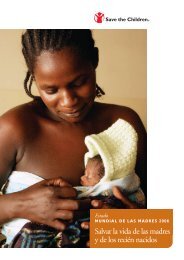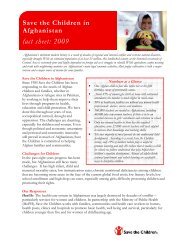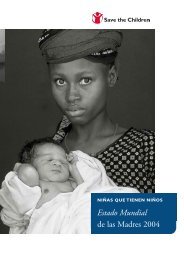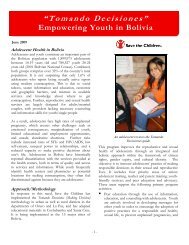The Power and Promise of Girls' Education - Save the Children
The Power and Promise of Girls' Education - Save the Children
The Power and Promise of Girls' Education - Save the Children
Create successful ePaper yourself
Turn your PDF publications into a flip-book with our unique Google optimized e-Paper software.
<strong>The</strong> data collected for <strong>the</strong> Mo<strong>the</strong>rs’ Index document <strong>the</strong><br />
tremendous gaps between rich <strong>and</strong> poor countries <strong>and</strong><br />
<strong>the</strong> urgent need to accelerate progress in <strong>the</strong> health <strong>and</strong><br />
well-being <strong>of</strong> mo<strong>the</strong>rs <strong>and</strong> <strong>the</strong>ir children. <strong>The</strong> data also<br />
highlight <strong>the</strong> regional dimension <strong>of</strong> this tragedy. Eight <strong>of</strong><br />
<strong>the</strong> Bottom 11 countries are in sub-Saharan Africa. That<br />
region also accounts for 14 <strong>of</strong> <strong>the</strong> 20 lowest-ranking<br />
countries.<br />
<strong>The</strong> contrast between <strong>the</strong> top-ranked country, Sweden,<br />
<strong>and</strong> one <strong>of</strong> <strong>the</strong> lowest-ranked countries, Ethiopia, is<br />
striking. A trained attendant is present at virtually every<br />
birth in Sweden, while only 6 percent <strong>of</strong> births are<br />
attended in Ethiopia. Nearly all Swedish women are<br />
literate, 72 percent are using some modern method <strong>of</strong><br />
contraception, <strong>and</strong> only 1 in 333 will see her child die<br />
before his or her first birthday. At <strong>the</strong> opposite end <strong>of</strong><br />
<strong>the</strong> spectrum, only 1 in 3 women is literate in Ethiopia,<br />
6 percent are using modern contraception, <strong>and</strong> 1 in 9<br />
children dies before his or her first birthday.<br />
Individual country comparisons are especially startling<br />
when one considers <strong>the</strong> human suffering behind <strong>the</strong><br />
statistics:<br />
• Fewer than 15 percent <strong>of</strong> births are attended by<br />
trained health personnel in Bangladesh, Ethiopia <strong>and</strong><br />
Nepal.<br />
• 1 woman in 10 dies in pregnancy or childbirth in Mali,<br />
Rw<strong>and</strong>a <strong>and</strong> Tanzania; <strong>the</strong> ratio is 1 in 7 in Malawi.<br />
• 3 <strong>of</strong> every 4 pregnant women in <strong>the</strong> Democratic<br />
Republic <strong>of</strong> Congo, Gambia, Madagascar <strong>and</strong> Turkey<br />
are anemic.<br />
Family Planning <strong>Save</strong>s Lives: As Contraceptive<br />
Use Rises, Maternal <strong>and</strong> Infant Deaths Decline<br />
122 in<br />
1,000<br />
6%<br />
1 in 10<br />
Mali Ug<strong>and</strong>a Bolivia Vietnam United<br />
States<br />
Infant mortality<br />
rate<br />
81 in<br />
1,000<br />
1 in 13<br />
53 in<br />
1,000<br />
18%<br />
27%<br />
57%<br />
19 in<br />
1 in 47<br />
1,000<br />
Lifetime risk <strong>of</strong><br />
maternal mortality<br />
1 in<br />
270<br />
71%<br />
7 in<br />
1,000 1 in<br />
2,500<br />
75%<br />
4 in<br />
1,000 1 in<br />
8,200<br />
Finl<strong>and</strong><br />
Percent <strong>of</strong> women using<br />
modern contraception<br />
<strong>The</strong> data in <strong>the</strong> Mo<strong>the</strong>rs’ Index indicate that increased access to<br />
<strong>and</strong> use <strong>of</strong> modern contraception can lead to dramatic<br />
improvements in infant <strong>and</strong> maternal survival rates. For<br />
example, in Finl<strong>and</strong>, where 75 percent <strong>of</strong> women use birth<br />
control, only 1 in 8,200 mo<strong>the</strong>rs dies in childbirth during her<br />
lifetime <strong>and</strong> 4 out <strong>of</strong> 1,000 infants do not make it to <strong>the</strong>ir first<br />
birthday. Compare this to Mali, where 6 percent <strong>of</strong> women use<br />
birth control, 1 in 10 mo<strong>the</strong>rs dies in childbirth, <strong>and</strong> 1 in 8<br />
infants dies before reaching age 1.<br />
Every year, millions <strong>of</strong> women <strong>and</strong> children in <strong>the</strong> developing<br />
world die as a result <strong>of</strong> births that are too close toge<strong>the</strong>r, too<br />
early, or too late in a woman’s life. In developing countries,<br />
maternal mortality is <strong>the</strong> leading cause <strong>of</strong> death for women <strong>of</strong><br />
reproductive age, killing 529,000 women a year.At least 1 in 9<br />
is a teenage girl. Every minute <strong>of</strong> every day, at least one<br />
woman dies from complications <strong>of</strong> pregnancy <strong>and</strong> childbirth.<br />
Family planning also makes important contributions to child<br />
survival. More than 10 million children under 5 die every year<br />
in <strong>the</strong> developing world. Family planning could prevent 25<br />
percent <strong>of</strong> <strong>the</strong>se deaths by spacing births at least two years<br />
apart, by helping women to bear children during <strong>the</strong>ir<br />
healthiest reproductive years, <strong>and</strong> by enabling parents to have<br />
<strong>the</strong>ir desired number <strong>of</strong> children.<br />
38<br />
THE POWER AND PROMISE OF GIRLS’ EDUCATION




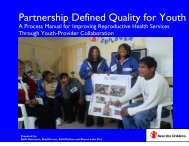

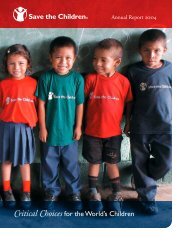
![View full document [PDF 3.39 MB] - PreventionWeb](https://img.yumpu.com/27308954/1/190x245/view-full-document-pdf-339-mb-preventionweb.jpg?quality=85)
